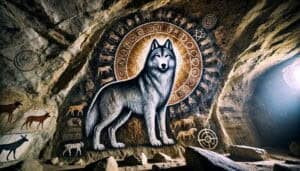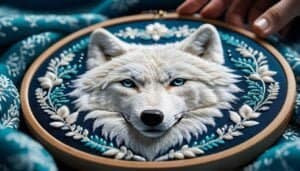Introduction
Arctic wolves hold a revered place in the traditions of Arctic communities, often symbolizing resilience, cunning, and survival. These majestic creatures are prominently featured in Arctic mask-making traditions, where they are represented through intricate and symbolic designs
This article will explore the cultural significance of Arctic wolves, their depiction in mask-making, the materials and techniques used in crafting these masks, and the role these masks play in community rituals and ceremonies
Additionally, we will delve into the preservation and display of Arctic wolf masks in museums and cultural institutions
Cultural Significance of Arctic Wolves
Arctic wolves, native to the harsh and frigid environments of the Arctic, hold profound cultural significance for the indigenous communities inhabiting these regions. Revered for their resilience and survival skills, these animals embody traits that are deeply respected and admired by Arctic peoples
This section delves into the symbolic meanings and roles of Arctic wolves in indigenous lore and ecosystems, shedding light on why they are featured prominently in traditional mask-making
Symbolism of Arctic Wolves in Indigenous Lore
Arctic wolves have been integral to the folklore and spiritual beliefs of Arctic indigenous communities for centuries
They are often seen as symbols of strength, endurance, and cunning—traits essential for survival in the unforgiving Arctic climate. In many stories and myths, the wolf is a guide, protector, and even a creator figure
For instance, in Inuit mythology, the wolf is sometimes associated with the spirit world, acting as a guardian and a teacher. Wolves are believed to possess deep wisdom and are revered for their hunting skills and ability to navigate the Arctic terrain. This reverence translates into artistic representations, where the wolf’s image is used to invoke protection and guidance from the spirit world
Role of Wolves in Arctic Ecosystems
Beyond their symbolic value, Arctic wolves play a crucial role in maintaining the balance of Arctic ecosystems. As apex predators, they help control the populations of herbivores, such as caribou and musk oxen, which in turn affects vegetation patterns and the overall health of the ecosystem
The presence of wolves ensures that the natural order is maintained, preventing overgrazing and promoting biodiversity
This ecological importance further cements the wolf’s status in indigenous cultures, as the survival of the community is closely linked to the health of the ecosystem. The wolf’s role as a key player in the Arctic food web underscores its significance in traditional beliefs and practices
Symbolic Meanings of Arctic Wolf Masks
Arctic wolf masks are not merely artistic creations; they are imbued with deep symbolic meanings. These masks often represent the qualities of the wolf—strength, cunning, and endurance—qualities that are admired and aspired to by the community
Wearing a wolf mask in a ritual or ceremony is believed to bestow these attributes upon the wearer, providing them with protection and power
In some cultures, the wolf mask is used during hunting rituals, symbolizing the hunter’s connection to the wolf and invoking the animal’s spirit to ensure a successful hunt. The masks can also be used in healing ceremonies, where the wolf’s perceived wisdom and connection to the spirit world are called upon to aid in the healing process
The intricate designs and craftsmanship of these masks reflect the deep respect and admiration for the wolf. The use of natural materials, such as animal skins, bones, and fur, further emphasizes the connection between the mask, the wolf, and the natural world
Depiction and Creation of Arctic Wolf Masks
Arctic wolf masks are not only culturally significant but also artistic masterpieces that embody the skills and traditions of Arctic indigenous artisans. The depiction of Arctic wolves in these masks involves intricate designs and symbolism, while the creation process requires knowledge of traditional materials and techniques
This section explores how Arctic wolves are artistically represented in masks, the materials and methods used in their creation, and specific crafting techniques
Artistic Representation of Wolves in Masks
The artistic representation of Arctic wolves in masks varies among different Arctic communities, but common themes include the wolf’s facial features, fur patterns, and expressions that convey its revered qualities
These masks often feature elongated snouts, pointed ears, and fierce eyes to capture the wolf’s essence. The use of colors and textures further enhances the representation, with natural hues like white, gray, and brown mirroring the wolf’s fur
In some cultures, the wolf mask may include additional elements such as feathers, beads, and carved symbols to enhance its spiritual significance. These adornments can represent various aspects of the wolf’s spirit or the natural environment it inhabits. The overall design aims to honor the wolf’s role in the ecosystem and its symbolic meanings in indigenous lore
Materials and Techniques Used
Creating an Arctic wolf mask involves a deep understanding of natural materials and traditional crafting techniques. Artisans typically use materials readily available in their environment, ensuring that the mask is both authentic and sustainable
Common materials include:
Animal Skins and Furs: These are used to cover the mask and provide a realistic texture. Wolf fur, in particular, may be used for authenticity
Bones and Antlers: These materials are often carved to create detailed features such as teeth, eyes, and structural support for the mask
Wood: Carved wood forms the base of many masks, providing a sturdy structure that can be adorned with other materials
Plant Fibers: Used for weaving and attaching various elements of the mask, plant fibers add flexibility and strength to the design
The techniques used to craft these masks are passed down through generations, preserving the cultural heritage and craftsmanship of Arctic indigenous communities. Carving, weaving, and sewing are common methods employed to assemble the mask, each requiring precision and skill
Specific Techniques to Craft Wolf Masks
Carving: The base of the mask is often carved from wood, using traditional tools to shape the wolf’s features. This process involves meticulous attention to detail, as the artisan must capture the essence of the wolf in the mask’s structure
Sewing and Weaving: Animal skins and furs are carefully sewn onto the wooden base, ensuring a snug fit and realistic appearance. Plant fibers may be woven to create decorative patterns or to secure additional elements to the mask
Painting: Natural pigments derived from plants, minerals, and other sources are used to paint the mask. The colors chosen reflect the wolf’s natural appearance and enhance its symbolic meanings
Adorning: The final step involves adding adornments such as feathers, beads, and carved symbols. These elements not only beautify the mask but also imbue it with cultural and spiritual significance
Community and Ritual Use of Wolf Masks
Arctic wolf masks hold a prominent place in the cultural and spiritual practices of Arctic indigenous communities. These masks are not only artistic representations but also vital components of various ceremonies and rituals
This section explores the role of wolf masks in traditional ceremonies, their evolution over time, and the deeper meanings associated with their use
Traditional Ceremonies Involving Wolf Masks
Arctic wolf masks are integral to a range of traditional ceremonies, each with its own unique significance and purpose. These ceremonies often revolve around themes of hunting, healing, and spiritual connection
Some of the key ceremonies include:
Hunting Rituals: Wolf masks are frequently used in pre-hunting rituals to invoke the spirit of the wolf
Hunters wear these masks to gain the animal’s attributes of cunning, strength, and endurance, believed to enhance their success in the hunt. The mask acts as a conduit between the human and animal worlds, fostering a deep connection with the wolf’s spirit
Healing Ceremonies: In many Arctic cultures, wolf masks play a role in healing rituals
The wolf’s perceived wisdom and protective qualities are called upon to aid in the healing process. Shamans or healers don the masks to embody the wolf’s spirit, seeking to drive out illness and restore balance to the individual and community
Spiritual and Seasonal Celebrations: Wolf masks are also featured in ceremonies that mark significant spiritual events or seasonal changes
For instance, during winter solstice celebrations, the masks may be worn to honor the wolf’s role in the Arctic ecosystem and to celebrate the enduring spirit of life during the harsh winter months
Evolution of Wolf Mask Traditions
The traditions surrounding wolf masks have evolved over time, influenced by changes in environment, societal structure, and external interactions. Despite these changes, the core values and meanings associated with wolf masks have remained resilient:
Adaptation to Environmental Changes: As the Arctic environment undergoes shifts due to climate change and other factors, the materials and methods used in mask-making may also adapt. Artisans might incorporate new materials or modify traditional designs to reflect current realities while maintaining the masks’ symbolic significance
Cultural Exchange and Integration: Increased contact with other cultures has led to the incorporation of new artistic elements and techniques into wolf mask-making. While this integration enriches the tradition, it also poses challenges in preserving the authenticity and original meanings of the masks
Contemporary Expressions: Modern indigenous artists often blend traditional and contemporary elements in their work. This fusion allows for the continuation of wolf mask traditions in new and innovative ways, ensuring their relevance in the present day
Symbolic Meanings Associated with Wolf Masks
The symbolic meanings of Arctic wolf masks are deeply rooted in the cultural and spiritual beliefs of Arctic indigenous communities. These masks are seen as embodiments of the wolf’s spirit, carrying powerful attributes and messages:
Protection: Wolf masks are believed to offer protection to the wearer, both physically and spiritually. By donning the mask, individuals seek to shield themselves from harm and negative influences, drawing on the wolf’s strength and vigilance
Guidance: The wolf’s role as a guide in folklore translates into the mask’s use in rituals that seek direction and insight. The mask serves as a tool for accessing the wolf’s wisdom and navigating complex life challenges
Unity with Nature: Wearing a wolf mask symbolizes a deep connection with the natural world. It reflects the belief in the interconnectedness of all living beings and the importance of living in harmony with the environment
The use of Arctic wolf masks in community and ritual contexts highlights their enduring cultural significance and the profound respect for the wolf as a symbol of survival and resilience
Preservation and Display of Wolf Masks
Arctic wolf masks, rich in cultural and artistic value, are preserved and displayed in museums and cultural institutions to ensure their legacy and educate future generations
This section examines the techniques used in conserving these masks, the role of museum exhibitions in cultural preservation, and the efforts made to maintain the authenticity and significance of these artifacts
Conservation Techniques
Preserving Arctic wolf masks involves a range of specialized techniques aimed at protecting them from deterioration while maintaining their historical and cultural integrity. Key conservation practices include:
Climate Control: Masks are often made from organic materials such as animal skins, fur, and wood, which are susceptible to damage from fluctuating temperatures and humidity
Museums use climate-controlled environments to maintain stable conditions, preventing the growth of mold, drying out of materials, and other forms of degradation
Pest Management: Organic materials attract pests like insects and rodents
Integrated pest management programs are implemented to monitor and control potential infestations. This includes regular inspections, using non-toxic repellents, and maintaining clean storage and display areas
Restoration: When masks show signs of wear or damage, conservators undertake careful restoration efforts
This may involve cleaning, repairing broken elements, and reinforcing weak areas using materials and techniques that match the original as closely as possible. The goal is to restore the mask’s appearance and structural integrity without compromising its authenticity
Documentation: Detailed documentation of each mask, including its condition, materials, and provenance, is essential for effective conservation. High-resolution photography, 3D scanning, and written records help track changes over time and guide restoration efforts
Museum Exhibitions and Cultural Preservation
Museums play a crucial role in preserving Arctic wolf masks and promoting cultural heritage. Exhibitions provide a platform for sharing these artifacts with a broader audience, highlighting their artistic and cultural significance
Key aspects of museum displays include:
Curatorial Practices: Curators work closely with indigenous communities to ensure that exhibitions accurately represent the cultural context and significance of the masks. This collaboration helps maintain the authenticity of the display and honors the traditions of the communities
Educational Programs: Museums often offer educational programs and workshops that provide deeper insights into the cultural heritage of Arctic wolf masks. These programs may include lectures, hands-on activities, and interactive displays that engage visitors and foster appreciation for indigenous art and traditions
Cultural Sensitivity: Exhibiting sacred and culturally significant items requires sensitivity and respect. Museums must balance public access with the cultural protocols of the originating communities. This might involve adhering to specific display practices, such as not exhibiting certain masks during particular times of the year or providing explanatory context about their significance
Community Involvement: Involving indigenous communities in the curation and interpretation of exhibitions ensures that their voices and perspectives are represented. This collaborative approach enhances the cultural relevance of the display and fosters mutual respect between museums and indigenous groups
Efforts in Maintaining Authenticity and Significance
Maintaining the authenticity and cultural significance of Arctic wolf masks involves continuous efforts from both conservationists and the originating communities
Key initiatives include:
Repatriation: Some museums engage in repatriation efforts, returning culturally significant items to their originating communities. This practice acknowledges the importance of cultural heritage and the rights of indigenous peoples to their ancestral artifacts
Cultural Continuity: Supporting the continuation of traditional mask-making practices helps preserve the cultural knowledge and skills associated with these artifacts. Workshops, apprenticeships, and cultural exchanges provide opportunities for younger generations to learn and carry forward these traditions
Collaborative Research: Joint research projects between museums and indigenous communities can uncover new insights into the history, use, and meaning of Arctic wolf masks. This research enhances the understanding and appreciation of these artifacts while respecting indigenous knowledge systems
By preserving and displaying Arctic wolf masks, museums and cultural institutions play a vital role in safeguarding cultural heritage and promoting awareness of indigenous traditions. These efforts ensure that the rich history and significance of Arctic wolf masks continue to inspire and educate future generations
Conclusion
Arctic wolf masks are more than artistic creations; they are deeply embedded in the cultural and spiritual fabric of Arctic indigenous communities
These masks symbolize strength, resilience, and the profound connection between humans and nature. Through intricate designs and traditional crafting techniques, they capture the essence of the Arctic wolf, reflecting the animal’s revered status in folklore and its vital role in the ecosystem
The cultural significance of Arctic wolves is highlighted in various traditional ceremonies and rituals where these masks are used to invoke protection, guidance, and healing. Over time, the traditions surrounding wolf masks have evolved, adapting to environmental changes and cultural exchanges while maintaining their core values
Preserving and displaying Arctic wolf masks in museums and cultural institutions is crucial for safeguarding this rich heritage
Conservation techniques ensure the longevity of these artifacts, while educational programs and community involvement help keep the traditions alive. Efforts to maintain authenticity and cultural relevance underscore the importance of respecting and honoring the originating communities
By understanding and appreciating the multifaceted significance of Arctic wolf masks, we can ensure that these powerful symbols of cultural identity and heritage continue to inspire and educate future generations











